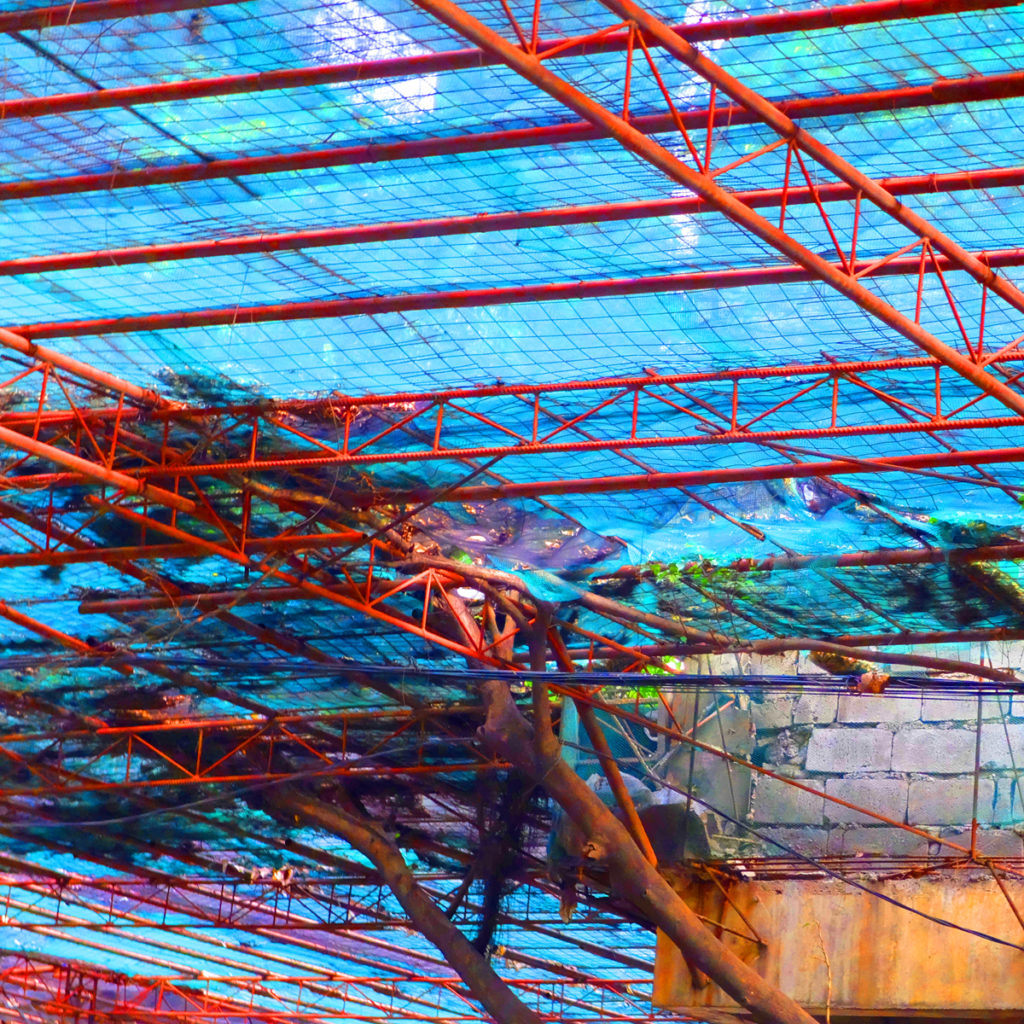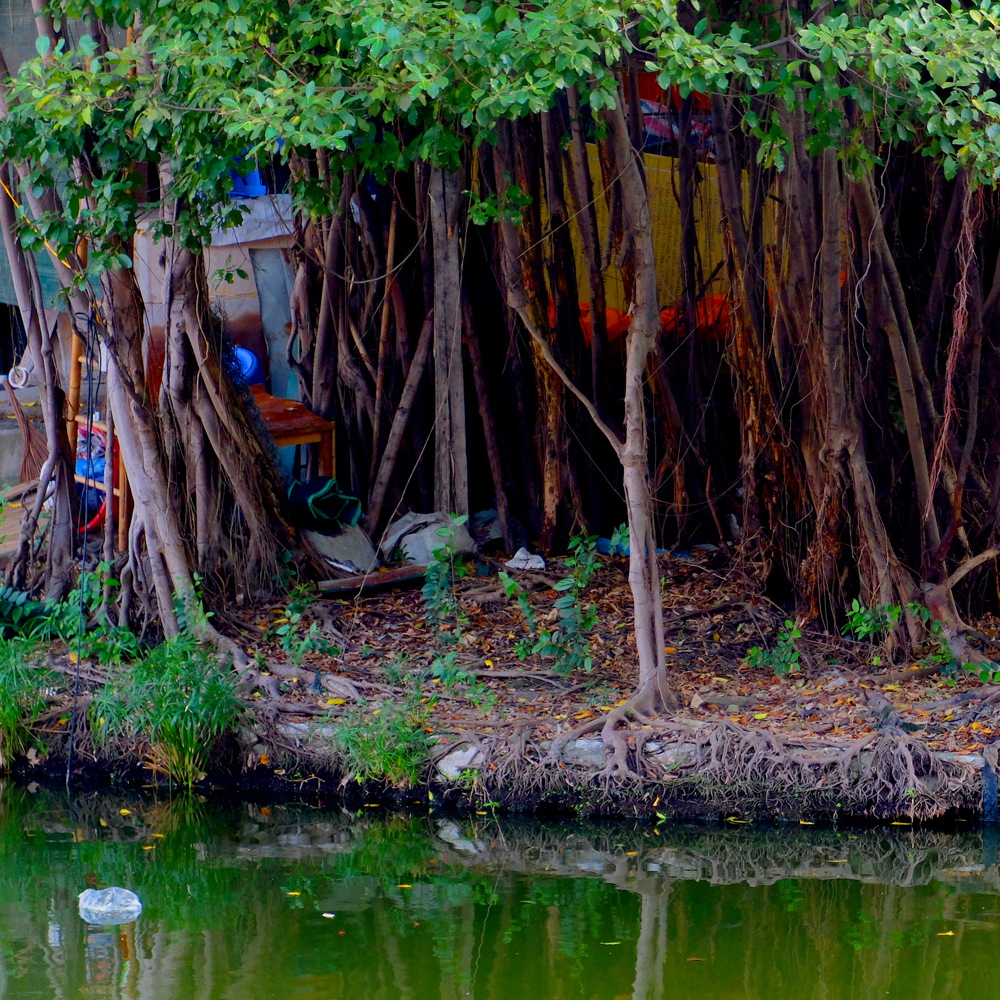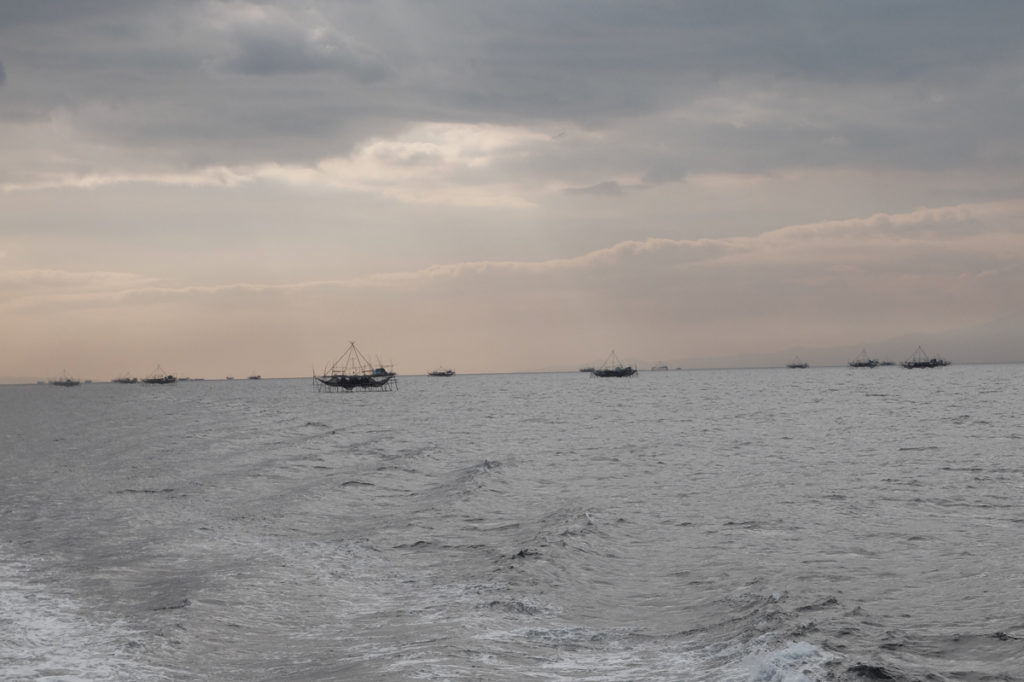by Aaron Vansintjan
A Craven is a floating island which, as some readers may know, is made up of debris and organic matter, largely held together by trees. Each Craven is home to about 200-600 Craveners, though there are some that house up to 5,000. The Craven Confederacy is made up of hundreds of thousands of floating islands dotting the Atlantic. Cravens breed fish, grow algae for ethanol, and harvest crops. They have an extensive trading network, being innovators in preserved foods, recycled microchips, and peer-to-peer wireless technology. The first Cravens were constructed—or rather, grown—about 300 years ago, in the first decades of the Climate Crisis. Named after an enigmatic figure referred to simply as ‘Craven’, it started as a politically-oriented, experimental farm on the Mains, close to what remained of New York City. It was then brought out to sea following a military crackdown on dissent. Since then, they have multiplied slowly, largely out of sight of global events. Today, while they may not rival the economic force of the Global Free Trade Company, or the military might of the Sino-Japanese, American, and Saudi empires, they represent a growing and significant power block in the world system.
And yet, for a first-time visitor, a Craven looks like a messy, unstructured place. There are barely any straight lines, nor does there seem to be much logic in where things are placed, or why. Plants grow all over, there isn’t too much coordination of who does what work, everything is incoherently cobbled together—not unlike a shantytown. In other words, there is no plan.
This was certainly my assessment when I first set foot on a Craven thirty years ago. I worked as an assistant on a trading skipper, dealing mostly in scavenged chips and rare metals. I had never grown my own vegetables, nor did I have any understanding of ecology—what Craveners refer to as ‘common knowledge.’
Trained as an engineer, I could only understand systems that approached order—inputs, outputs, scale, closed or open systems. My experience had told me the most productive industries were organized, clean, and depended on an economy of scale. What I saw on the island did not look like any of the models I had learned about, so I assumed Craveners knew very little about science, efficiency, or industrial design. Theirs was an undeveloped society, I thought, and their success over the past centuries has been largely accidental.
Despite my patronizing attitude, I found that, in business, Craveners were reliable, fair, and delivered quality products. So when I had saved up enough money to start my own skipping business I kept coming back. And as I got to deal with Craveners more I started seeing patterns. I got curious about what they were actually doing. Craveners aren’t very guarded, so I also learned to ask lots of questions.
This is how the conversation often went: I’d point at something, say, one of the many towers dotting one island, and they’d say, ‘That? It’s a pigeon tower.’ ‘What does it do?’ I’d ask. ‘The pigeons feed the soil.’ ‘They feed the soil?’ I’d ask, waiting for more explanation. The Cravener would pause, look at me, confused that this wasn’t self-explanatory. ‘Their dung has nitrogen and phosphorus, doesn’t it?’ they’d respond, ‘but that’s common knowledge,’ they’d add. I soon found that Craveners don’t really see what they are doing as complicated or requiring ‘expertise’. From their perspective, they aren’t doing anything special.
The difficulty of trying to describe Cravener production methods is that each Craven is so different. While many anthropologists have spent lifetimes living on a Craven, doing so does not provide a broad understanding of what techniques they use. Further, knowledge transfer is notoriously decentralized—they may host gatherings and conferences to exchange information, and there may be wikis on different technologies and practices, but there is no central repository, as far as I know at least, about all the practices and technologies that are actually in use. The problem is similar to that of being an Internet historian: you can’t know what is worth reading without some kind of wider knowledge of the Internet era; some theoretical framework by which to assess what is factual, what is useless, or what amounts to a conspiracy theory.
What’s more, Cravener production techniques don’t involve much prior planning. Many practices seem to require highly technical implementation and maintenance, an understanding of wider systems. And yet, construction seems to happen in a very hodge-podge manner, with no clear moment of decision-making. I have rarely witnessed a Cravener creating a model of what they wanted to build. Rather, Cravener infrastructure, with some exceptions, seems to be guided by a kind of vernacular ‘know-how’, instilled into a Cravener from the moment that they’re born.
For example, I’ll often see Cravener children touring the island with an adult, and they’ll stop by some kind of structure. The children will ask questions, and if the adult doesn’t know, they might ask someone working nearby. Children, even when young, might be asked to help build something—and so they learn how it works through practice. As they grow up, they engage in play where they build small versions of these technologies—the same way children on the Mains might build high-risers on the beach. When whole Cravens come together for a festival or a conference, children will travel with their parents to visit relatives and then learn about other Cravener practices. At these conferences, teenage Craveners are organized into teams and asked to come up with an invention, and those that come up with a creative design will be presented with an award. However, the models are not taught in a single ‘course’, the participants in the competitions base them on what they already know from a lifetime of experience. These experiences are not categorized into ‘fields’ but drawn from a kind of general understanding of ecology, design, or even their own society—necessary for knowing the extent to which a new technical practice can be reasonably adopted by their peers.
Of course, many Craveners do specialize as they get older, joining, for example, breeding and genetic modification labs, or spending years building and experimenting with new structures as part of what they call a ‘technical committee’. As many other researchers have documented, Craveners will also participate in a kind of ‘internal participatory ethnography’, where they move to another Craven known for a particular craft and learn from other specialists. And as goes without saying, their conferences can themselves be quite specialized, often focusing on a specific technology or even minutiae like the most ideal water dripping rate needed to grow tomatoes in an aquaponic system. But what they discuss at the conference is rarely implemented at scale or even adopted widely–and so the conferences cannot be seen as representative of Cravener means of production. They constitute more of a ‘best practices’ of what really happens ‘on the ground.’
Only repeated visits to multiple Cravens over a long time period, as well as multiple interviews of Craveners, can allow a researcher to deduce, from general visible patterns, the Cravener mode of production and the specific technologies that power it. I have been a Craven-approved merchant over three decades, which has allowed me to visit over 400 Cravens with a total of about 2,200 unique visits. I’ve also attended 43 Craven conferences. These experiences have provided me with valuable insight into Craven production processes, and the differences and similarities between Cravens. In fact, my research method can be seen as a kind of statistical ethnography, as my accumulated experience is somewhat representative of Cravener society as a whole.
In this book, I describe and catalogue the unique technologies that I believe represent the foundation of the Craven mode of production. I focus largely on specific techniques used in production that make up what Craveners call ‘island ecology’. Technologies can be seen as general ‘types’ that are somewhat isomorphic across Cravens. I hope that this book is useful for anyone who is interested in Craven society, or (even better) wants to start their own Craven society and is curious how they could do so. Further, I believe that understanding these technologies will help readers understand why Cravens have become so successful in a world dominated by insecurity, violence, and ecological collapse.
From a Cravener perspective, of course, ‘technologies’ barely exist. Tools, constructions, and techniques are embedded within their day-to-day lives, rituals, and even political system. They are, as such, indistinguishable from their society as a whole, in the same way that it is difficult to tell the difference between ‘culture’ and ‘religion’ in many other societies. For this reason, one might instead use the term ‘practices’.
Further, it is difficult to formalize these practices into a coherent field of study such as ecology, agriculture, engineering, or sociology. Following previous scholars in the field of Craven studies, I prefer to use the Craven term, ‘common knowledge’, connoting the scientific-social-ecological know-how that allows them to maintain their mode of production and has driven their success over time.
In any case, the reader should keep in mind that these practices are indistinguishable from Craven society as a whole—without their social norms, rituals, and political system, they would certainly not have come close to the kind of astonishing economic success that they enjoy today.
Of course, it’s impossible to write a book about all of Craven society, so I have chosen to focus on the technologies that drive their political economy. However, I hope that the reader will get a sense of how these technologies are integrated within an organic, but holistic, political system. Despite the seemingly disorganized nature of Craven production methods, underlying it is a coherent political system that ensures democratic, and open, economic participation.
As it turns out, what at first appeared to me to be an inefficient and unruly production method, with little centralized direction, is in fact a hyper-productive economic system that encourages constant innovation and experimentation. In other words, a society predicated on the natural abundance of the air, sun, water, and soil—rather than one that has regulated everyone into scarcity. Instead of an economy of scale, a political ecology of scale. The technologies highlighted in this book are an essential part of that ecology.
All photos by Aaron Vansintjan
Aaron Vansintjan is a co-editor at Uneven Earth and is currently pursuing a PhD at Birkbeck, University of London. He writes about gentrification, food politics, environmental justice, and contemporary politics.




